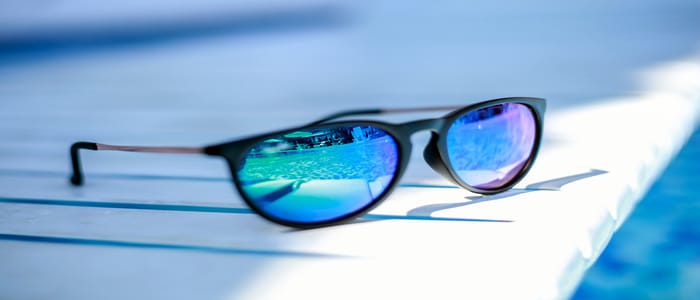
Get the Best Lenses by Knowing the Benefits and Drawbacks
There’s a price for living in a state that has an average of 300 sunny days per year. If you live in Arizona, you don’t often have to deal with snow shovels and parkas, but you almost always think about how the sun will affect you. From staying hydrated to wearing sunscreen, there are steps every Arizonan needs to take to be healthy and comfortable in the sun—and wearing the right protective lenses is one of them.
Your choice in sunwear is particularly important. Although UV lenses help protect your eyes and the skin around your eyes from the damaging ultraviolet light, they don’t eliminate the distracting and blinding glare that causes visual discomfort in any sunny situation.
Polarized lenses eliminate glare, but they may not be the perfect solution for every situation. This article explores how polarized lenses work, their benefits, their potential drawbacks and where to buy them.
What Is Glare?
When a bundle of light hits a flat surface, it becomes polarized, or is reflected horizontally. The bundle becomes concentrated and is blinding anyone observing it. This is referred to as blinding glare.
These reflections can be uniform, which is light reflected from a smooth service. Uniform reflections would be light reflected off the road, or off a car’s bumper or back window. They can also be non-uniform, which is light reflected from an uneven surface. An example of this would be light reflected off running water or a patch of ice on the road.
No matter what the case, the desired result is to filter out the distracting reflected light and provide a clear viewing experience for the wearer.
What are Polarized Lenses?

During the manufacturing process, a special chemical is applied to an eyeglass lens to polarize it. The chemical is laminated in a vertical pattern, which reorganizes light. This pattern blocks the light that is horizontal to eliminate glare, which is similar to how a window blind works.
Glare typically happens when waves of light bounce off reflective surfaces, such as a lake, snowy hillside, or shiny car bumper. Because the surface is horizontal, the light is reflected horizontally. When you are wearing polarized sunglasses, the surface blocks the glare by filtering out the horizontal light waves that don’t fit through the chemical laminate pattern.
Images may appear darker while wearing polarized lenses. However, when glare is eliminated, the image details are easier to see. and can reduce eye strain. Plus, polarized lenses also provide protection from harmful UV rays.
Polarized Lens Differences
Inexpensive polarized sunglasses differ from more expensive lenses in significant ways. Cheaper sunglasses may only have a thin chemical laminate on one side of the lens. The thin layer may only provide minimal benefit and the thin layer can be rubbed or scratched off easily. You may also notice aberrations in your lenses, as these are usually mass produced stamped out lenses that are lower quality.
Higher quality options have film laminated between two layers of lens material. Encasing the laminate protects it from being scratched and provides additional benefits. The thicker the polarizing film, the more protective the lens is against glare.
A note about lens color: darker lenses are not a sign of better protection. Ask your eyeglass retailer or optometrist how the polarized laminate is applied to the eyewear before you purchase it. As far as other options go, polarized glasses are available in a wide variety of colors, materials and lens designs.
How Polarized Lenses Work for You
In addition to reducing glare, polarized lenses ease eye strain from long hours in the sun. And if you experience headaches due to light sensitivity, polarized lenses may help you experience fewer occurrences and less intense headaches.
Polarized lenses can also increase visual clarity, contrast, and acuity, making your environment more enjoyable. And when you’re able to see better, you may be able to mentally determine what you’re seeing quicker, which can help improve reaction time.
Bonus advantage: If you are a recreational or commercial fisherman or boater, polarized glasses can allow you to see below the surface of the water, so you catch more fish and maneuver the water safely.
Polarizations Limits
Liquid crystal displays (LCDs)—which are common on cell phone screens, auto dashboards, clocks and other instrument displays—can be difficult to see clearly when wearing polarized lenses. They are especially troubling for pilots who may have trouble reading their instrument panel and also viewing objects in the sky, including other planes.
Because polarization blocks some light, night time use isn’t recommended for safety reasons.
Polarized sunglasses are available at numerous retail locations, from your local drug store to high-end sunglass retailers. If you’re buying these glare-blocking sunglasses to reduce eye strain, make sure you’re getting your money’s worth. Consult with a professional to help ensure you receive accurate information about your eyewear. Also, depending on the level of strain and discomfort your experience with sunlight, there may be another issue that your eye doctor should know about.
Consult with a qualified eye care professional today if you have questions about how polarized lenses work and if they’re right for you.


